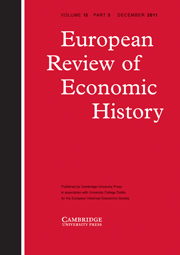Crossref Citations
This article has been cited by the following publications. This list is generated based on data provided by
Crossref.
Milanovic, Branko
2009.
The New Palgrave Dictionary of Economics.
p.
1.
Prados de la Escosura, Leandro
and
Rosés, Joan R.
2009.
The Sources of Long-Run Growth in Spain, 1850-2000.
The Journal of Economic History,
Vol. 69,
Issue. 4,
p.
1063.
Timmons, Jeffrey F.
2010.
Does Democracy Reduce Economic Inequality?.
British Journal of Political Science,
Vol. 40,
Issue. 4,
p.
741.
Scholtz, Hanno
2010.
Inequality rose from above, so it shall fall again: Income skewness trends in 16 OECD countries as evidence for a second Kuznets cycle.
International Journal of Comparative Sociology,
Vol. 51,
Issue. 4,
p.
246.
Baten, Joerg
and
Mumme, Christina
2010.
Globalization and educational inequality during the 18thto 20thcenturies: Latin America in global comparison.
Revista de Historia Económica / Journal of Iberian and Latin American Economic History,
Vol. 28,
Issue. 2,
p.
279.
María-Dolores, Ramón
and
Martínez-Carrión, José Miguel
2011.
The relationship between height and economic development in Spain, 1850–1958.
Economics & Human Biology,
Vol. 9,
Issue. 1,
p.
30.
Beltran Tapia, F. J.
2012.
Commons, social capital, and the emergence of agricultural cooperatives in early twentieth century Spain.
European Review of Economic History,
Vol. 16,
Issue. 4,
p.
511.
Esteve, Vicente
and
Tamarit, Cecilio
2012.
Is there an environmental Kuznets curve for Spain? Fresh evidence from old data.
Economic Modelling,
Vol. 29,
Issue. 6,
p.
2696.
Abad, Leticia Arroyo
2013.
Persistent Inequality? Trade, Factor Endowments, and Inequality in Republican Latin America.
The Journal of Economic History,
Vol. 73,
Issue. 1,
p.
38.
Santiago-Caballero, Carlos
2013.
TRAPPED BY NATURE: PROVINCIAL GRAIN YIELDS IN SPAIN IN THE MID 18TH CENTURY.
Revista de Historia Económica / Journal of Iberian and Latin American Economic History,
Vol. 31,
Issue. 3,
p.
359.
Foldvari, Peter
van Leeuwen, Bas
Marks, Daan
and
Gall, Jozsef
2013.
Indonesian regional welfare development, 1900–1990: New anthropometric evidence.
Economics & Human Biology,
Vol. 11,
Issue. 1,
p.
78.
Lains, Pedro
da Silva, Ester Gomes
and
Guilera, Jordi
2013.
Wage inequality in a developing open economy: Portugal, 1944–1984.
Scandinavian Economic History Review,
Vol. 61,
Issue. 3,
p.
287.
BELTRÁN TAPIA, FRANCISCO J.
2013.
Enclosing literacy? Common lands and human capital in Spain, 1860–1930.
Journal of Institutional Economics,
Vol. 9,
Issue. 4,
p.
491.
van Zanden, Jan Luiten
Baten, Joerg
Foldvari, Peter
and
van Leeuwen, Bas
2014.
The Changing Shape of Global Inequality 1820–2000; Exploring a New Dataset.
Review of Income and Wealth,
Vol. 60,
Issue. 2,
p.
279.
Lapuente, Victor
and
Rothstein, Bo
2014.
Civil War Spain Versus Swedish Harmony.
Comparative Political Studies,
Vol. 47,
Issue. 10,
p.
1416.
Torregrosa Hetland, Sara
2014.
Sticky Income Inequality in the Spanish Transition (1973-1990).
SSRN Electronic Journal,
de la Escosura, Leandro Prados
2014.
The Cambridge History of Capitalism.
p.
501.
Bengtsson, Erik
2014.
Labour's share in twentieth-century Sweden: a reinterpretation.
Scandinavian Economic History Review,
Vol. 62,
Issue. 3,
p.
290.
Cornell, Agnes
and
Lapuente, Victor
2014.
Meritocratic administration and democratic stability.
Democratization,
Vol. 21,
Issue. 7,
p.
1286.
Domenech, Jordi
2015.
Land Tenure Inequality, Harvests, and Rural Conflict: Evidence from Southern Spain during the Second Republic (1931–1934).
Social Science History,
Vol. 39,
Issue. 2,
p.
253.


